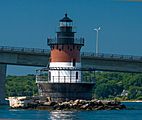Plum Beach Light facts for kids
 |
|
| Plum Beach Light ca. 1910 | |
|
|
|
| Location | Narragansett Bay north of the Jamestown Verrazzano Bridge |
|---|---|
| Coordinates | 41°31′49″N 71°24′19″W / 41.5303°N 71.4052°W |
| Year first constructed | 1897 |
| Deactivated | 1941 |
| Foundation | Iron caisson |
| Construction | Cast iron/concrete |
| Tower shape | conical "sparkplug" tower |
The Plum Beach Light is a historic lighthouse in North Kingstown, Rhode Island. It was built in 1899. This lighthouse is a special type called a sparkplug lighthouse.
It was built using a method called pneumatic caisson engineering. A strong granite base was added in 1922. The lighthouse stopped working in 1941. This happened when the first Jamestown Bridge was built nearby.
Over time, the lighthouse fell into disrepair. But in 1999, a group called the Friends of Plum Beach Lighthouse took over. They worked hard to save it. The lighthouse is now listed on the National Register of Historic Places. This means it's an important historical site.
In 2003, the outside of the lighthouse was fully fixed. Its light was turned back on soon after. Today, it helps guide boats as a private aid to navigation. The Friends group even created special license plates for Rhode Island. These plates feature the lighthouse and help raise money for its care. Over 7,000 sets of these popular plates have been sold since 2010.
Contents
History of Plum Beach Light
Building the Lighthouse
Work on the Plum Beach Lighthouse began in 1896. It was built using a special method called a pneumatic caisson. Imagine a giant, hollow box. The lighthouse's base was built on land. Then, it was floated to its spot in the water. Workers then sank it to the bottom of the bay.
Once the base was settled, water was pumped out. Air was pumped in instead. Workers went inside this air-filled space. They dug out dirt from the bottom. As they removed dirt, the foundation slowly sank deeper.
During construction, they found a seven-foot layer of quicksand. This was a big problem! They had to stop building. The foundation needed to be made taller to get past the quicksand. This meant they needed more money.
The unfinished foundation was covered with a wooden roof. A red light was placed on it in 1897. In 1898, Congress approved $9,000 to finish the job. Work started again in April 1899. It was completed in June 1899. The lighthouse first shone its light on July 1, 1898.
When the Lighthouse Was Abandoned
The Jamestown Bridge was finished in 1940. Because of the bridge, the lighthouse was no longer needed. The Coast Guard officially turned off its light on May 1, 1941.
Soon after, the lighthouse was offered for sale. The Coast Guard wanted someone to tear it down or move it. But no one wanted to buy it. So, the lighthouse was left empty.
Over the years, the lighthouse's windows and doors disappeared. Pigeons moved in and made it their home. The floors became covered in thick bird droppings. It was not safe for people to go inside without protection.
In the early 1970s, some university researchers studied the pigeons there. They wore special masks and clothes. They learned how the pigeons controlled their population.
Efforts to Save the Lighthouse
Not much was done to protect the lighthouse for a while. In the mid-1970s, someone tried to paint it. But the work stopped because a painter got sick from the bird droppings.
For many years, the Coast Guard and the State of Rhode Island argued. Neither wanted to pay for the lighthouse's upkeep. This argument was finally settled in 1998. A painter who had worked there sued the state. He said he got sick from the bird droppings. The courts decided the state owned the lighthouse. The state then paid the painter.
Private Group Takes Over and Restores It
In 1988, a company wanted to buy the lighthouse. They planned to move it to Massachusetts. They wanted to turn it into a museum. But a local resident, Shirley Silvia, had a different idea. She started a group called the Friends of Plum Beach Lighthouse. Their goal was to buy the lighthouse. They wanted to fix it up and keep it in its original spot.
Neither group could buy it at first. This was because of the ownership dispute. But in 1999, the State of Rhode Island officially got the deed. They then gave ownership to the Friends of Plum Beach Lighthouse. This was a big moment for the group.
In the same year, the Friends received a large grant. It was $500,000 to help restore the tower. In 2000, architects estimated it would cost $955,000 to fix the entire lighthouse.
In 2009, the Friends group got approval for special license plates. These plates feature a picture of the lighthouse. Money from the plates helps maintain the lighthouse. They needed to sell 900 plates to start. The Friends sold more than that in just eight weeks! Since then, over 10,000 plates have been sold. This money helped repaint the lighthouse in 2010 and 2017.
Gallery





